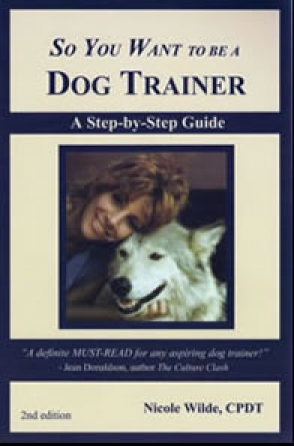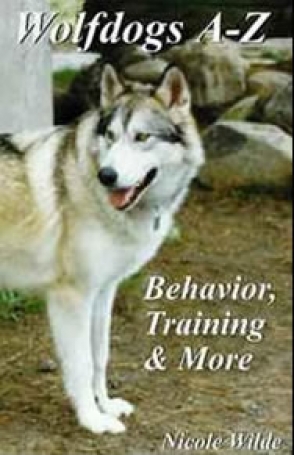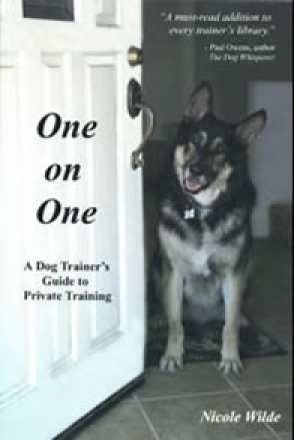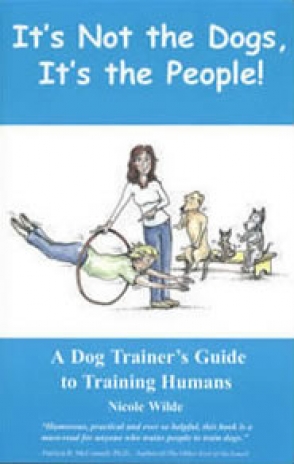This step-by-step guide contains invaluable resources for the aspiring or established professional dog trainer.
Throwing Away the Box
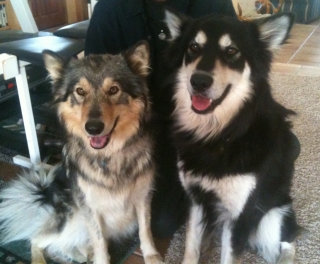
Trainers and owners alike are taught that there are specific ways to solve canine behavior problems. But one method, regardless of how scientifically sound or effective, won’t work for every dog. Sometimes it’s necessary to think outside the box; and sometimes, it comes to throwing the box away altogether.
Some of you may already know about Sierra, the two-year old, mostly-keeshond-husky mix we adopted ten months ago from the shelter. What you may not know is that two months ago we adopted Bodhi, a year-and-a-half old male husky mix, also a shelter rescue (that's him on the right). He’d belonged to a college guy who couldn’t afford his upkeep, or so the story goes. My guess is that the poor guy returned to his dorm room one night to find Bodhi having a keg party, music blasting (Who Let the Dogs Out, of course), the room in shreds. Bodhi is easily the most destructive dog I’ve ever owned. And having owned wolves and wolfdogs, that’s saying a lot. Bodhi has eaten small items like a house phone and various paperback novels, as well as major appliances, like an outdoor mini-fridge. Although he’s not a young puppy, he obviously never learned house rules such as don’t grab things and eat them when someone isn’t watching you for all of two seconds.
There have been major issues in the two months we’ve had Bodhi: he and Sierra fought for the first two weeks, although there was no bloodshed during this “acclimation period.” They will, however, fight over resources to this day. It’s been a challenge to find chew items that can be left out that will entice Bodhi enough to chew on them, but not so high value that the dogs will fight over them. After much trial and error, I’ve learned that leaving plenty of antlers, clean, empty Kongs, Galileo bones, and Nylabones works. (I don’t normally recommend the latter two as they’re plastic—albeit the type that flakes in tiny pieces that easily pass through a dog’s digest tract—but in this case, I’ve made an exception.)
Having to get creative with chew items might have been thinking outside the box, but at least there was a box. Dealing with Bodhi’s pushiness is another story. Insecure, needy dogs often crave attention, and Bodhi is no exception. This, combined with his automatically wanting whatever Sierra has—in this case, attention—results in him bodily inserting himself into the midst of things whenever my husband or I reach to pet Sierra. Before Bodhi came, one of my favorite things was to pet Sierra to the point where she’d roll over for tummy rubs, her front legs sticking straight up, a grin on her face that’s as close to goofy as she gets. But that all changed with Bodhi’s arrival, as she didn’t feel safe in that position with him nearby. At first, I implemented a typical behavior modification scenario, where I had Bodhi down-stay on a dog bed while I petted her on the nearby couch, rewarding him periodically with treats for lying calmly. This worked, and it improved his behavior some, but it didn’t really solve the problem in other scenarios, like when they both rushed to greet my husband or me.
I started to think about the underlying reasons Bodhi acts the way he does. He’s in a new place, he’s insecure, and he’s anxious. (Okay, and he’s also just a pushy adolescent male, but I don’t have a magic wand for that.) If I could make him feel less anxious and more a part of the family, he might behave better. I have to admit that due to the fighting between the dogs, the destruction, Bodhi's on-leash dog reactivity, and a host of other issues, I had been wondering whether we’d made the right decision in adopting him. I’d felt at a loss to truly form a bond with him, which is highly unusual for me. Because of that, I’d been acting less lovingly than I would normally toward a furry family member. And so, I mounted a Cuddling Offensive. Yes, this was all-out war; that dog was going to get attention and cuddling until he submitted! Sure, I can hear you thinking, but a leadership program would have helped more. Check! One had been in place since day one, and although it had helped some with his manners (sitting and waiting for food is a huge deal for him, but he does it well now), it didn’t help with this. And just insisting on his staying out of things would have worked as well, but if I even raised my voice to correct him, Sierra, being the sensitive creature that she is, would cower. After a week or so of Operation Cuddle, the extra attention paid off. Bodhi visibly relaxed. It may be that my acting “as if” I felt more affectionately toward him helped too, in that it actually brought us closer together. Since Bodhi was now getting plenty of attention, it was no big deal for him to lie nearby while Sierra enjoyed her tummy rubs.
Another area where I used a different tactic than I normally would is with handling exercises. You probably already know that many resource guarders also have handling issues. In our southern California desert town we have plenty of foxtails—pointed, dried out, weedy growths that can be fatal if they work their way into a dog’s skin. At certain times of year, it’s critically important to be able to check between furry toes for them on a daily basis. When I first tried to do this with Bodhi, he didn’t bite, but he did place his large, strong jaws gently around my forearm as if to say, “I’d really rather you didn’t. Please, let's not take this to the next level.” Normally, with clients’ dogs (and even my own), I would incorporate classical conditioning in the form of gradual handling paired with food treats. Food works for Bodhi in a big way, but what I needed in this case was for him to lie calmly, and he’s so food-crazed that I didn’t think he’d be capable of that with food around. So once again, I completely changed tactics and instead just proceeded very slowly, using long, calm petting strokes paired with a soothing tone of voice, taking intermittent peeks between his toes. Over time, the teeth left my forearm as Bodhi realized that I was not going to hurt him or force him. Checking for foxtails is now much easier, and less stressful for both of us. We’re not at the point where he’s lying there happily as I clip nails or do something invasive, but it’s progress, and I can brush him out now as well, thanks to the same technique.
One more unorthodox tactic: because Bodhi seemed to feel the need to constantly grab things off tables, counters, and the floor (normally followed by chewing them), and I couldn’t (or didn’t want to) supervise 24-7, I laid out a row of empty Kongs and other hard rubber items on the top of the washing machine, one of his prime spots for grabbing things until we’d figured it out and stopped leaving dish towels and other items up there. Now when he’s unsupervised and feels the need to grab something, he puts his front paws up on the washing machine, grabs an empty Kong, and takes it outside. I know, it goes against traditional thinking to allow him to practice the bad behavior, and worse, to get rewarded for it. But I had to do something, and it worked. The argument could also be made that the unwanted behavior has effectively been directed and confined to an acceptable area, much as one creates a digging pit so a dog won’t dig up the whole yard.
Sometimes, when your back’s against the wall and the usual tools in your toolbox don’t fit the job at hand, you’ve just got to throw away the box and start from scratch. Maybe that’s a good thing for us trainers, as it keeps us on our toes. It's good for the dogs too, as a little creativity can make the difference between a loving, forever home and a dog who gets constantly bounced around or worse. Here's to throwing away the box.

